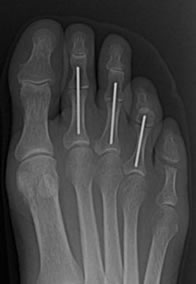Small Joint Fusion (PIPJ or DIPJ)

A small joint with a large name the PIP (Proximal Interphalangeal) joint is the first joint of the small toes. The reason for surgery is when this joint has a fixed curved (Claw Toe or Hammer Toe) deformities. The deformity develops gradually and it cannot be straightened because it has been bent and fixed in this position for a long period of time.
The procedure essentially straightens the joint and fuses it in the straightened position.
This operation is also performed for metatarsalgia (pain under the ball of the foot). It involves excising (removing) the joint surfaces and then pinning the joint straight, until the fusion has united (the bone has grown across). This is performed through an incision across the dorsum (back) of the joint, approximately 2cm across. Older surgical methods left a pin protruding from the tip of the toe to be removed weeks later, but modern implants are now hidden within the toe and there is no protruding pin.
Risks of surgery
Stiffness & swelling
Initially the toe will be very swollen and needs elevating. The swelling will disperse over the following weeks & months but may still be apparent at 6 months.
Infection
There is always a risk of infection with surgery. You will be given 1 dose of intravenous antibiotics during surgery. The best way to reduce your chances of acquiring an infection, is to keep the foot elevated for 7 days. If there is an infection, it normally resolves with a course of oral antibiotics.
Nerve damage
The nerves supplying the toe, lies alongside the joint and are at risk of damage. Usually there is no damage, but sometimes the nerves may be bruised or even cut. If they are just bruised, they will recover. If the damage is permanent, it will leave a small patch of numbness. This does not normally cause any disability.
Non union
If the fusion fails to unite (heal), this may leave some residual swelling or pain. It is uncommon for this to be severe enough to warrant further surgery. Revision surgery is only slightly more complex than the original surgery and has good results.
Recovery from surgery
Elevation of the foot (above the pelvis) for the first 7 days is vitally important to prevent infection. Naturally, small periods of walking and standing are necessary.
This type of operation and the post operative shoe allow weight bearing immediately. The fusion requires protection in the post operative shoe for 6 weeks.
The surgery is routine, but the recovery is prolonged and swelling is the last feature to recover. Often shoeware will still be tight at the 6-week stage.
Activity and time off work
In general, up to 2 weeks off work is required for sedentary posts and up to 6 weeks for standing or walking posts.
Follow up
- 2 weeks for removal of sutures
- 6 weeks for weight bearing X-ray